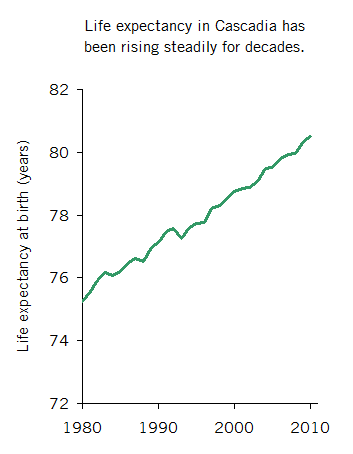The people of Cascadia are living longer than ever before—a sign of robust and improving health. As of 2012, Cascadians’ lifespans had grown to 80.5 years—an increase of more than 5 years since 1980. Unlike many other quality of life indicators in Cascadia, life expectancy has improved steadily for decades. These improvements show little sign of abating, as the toll from virtually every major cause of death continues to decline.
Life expectancy—the average number of years a newborn can expect to live, given current patterns of mortality—is perhaps the best single gauge of a population’s health. The lifespan measurement integrates all maladies that can shorten lifespans, from infant mortalities to heart disease to traffic accidents to cancer. National and international comparisons show strong correlations between life expectancy and other measures of health, such as the number of years people live free of disability, rates of preventable illness, and even people’s satisfaction with their own health. Life expectancy is measured consistently throughout the region, and official figures are reported with minimal delay—making it ideally suited for comparing the health of different populations.
 Within Cascadia, health has improved unevenly. British Columbia has long been the healthiest jurisdiction in the region, but in the last three decades it has expanded its lead over the Northwest states. Today, residents of BC can expect 82.8 years of life on average, topping all other North American states and provinces. If the province were an independent nation, it would rank among the most healthy countries in the world, trailing only the likes of Japan.
Within Cascadia, health has improved unevenly. British Columbia has long been the healthiest jurisdiction in the region, but in the last three decades it has expanded its lead over the Northwest states. Today, residents of BC can expect 82.8 years of life on average, topping all other North American states and provinces. If the province were an independent nation, it would rank among the most healthy countries in the world, trailing only the likes of Japan.
British Columbia’s healthiest residents live in south of the province. The healthiest jurisdiction in British Columbia–and in Cascadia overall–is the suburban city of Richmond, BC, where lifespans exceed 84 years. That’s higher than in Japan, and also higher than those of any major county in the United States.

Residents of southern British Columbia have the region's longest lifespans. Map updated in 2007, based on data from CDC Wonder and BCStats.
The Northwest states don’t fare as well, with average lifespans trailing BC’s by nearly three years. The Northwest counties with the longest lifespans–Washington County, Oregon, and King County, Washington — aren’t even standouts among populous US counties.
British Columbians’ success in leading long, healthy lives results not from one single cause, but from many. None of the province’s inhabitants goes without health insurance–unlike the one in seven residents of the Northwest states who do so currently (though recent changes in US health policy may narrow that gap). BC also has lower rates of violent deaths: fewer homicides and also fewer fatal car crashes, the latter largely due to compact communities that allow residents to drive less. And the province also has lower rates of severe obesity than the Northwest states. Differences in economic security may play a role as well: income and wealth gaps between the rich and the poor are narrower in British Columbia than in the Northwest states. Around the world, wide gaps between haves and have-nots tend to be associated with poor health.
The recent efforts by the US government to improve access to health care may bear fruit in the years to come, improving lifespans for residents of the Northwest states. But improving access to medical care is only part of the solution to a healthier population. Just as important are more systemic changes that keep us healthy without medical intervention. Redesigning our neighborhoods so that we can walk more and drive less, for example, would help promote regular exercise, limit deaths and injuries from car crashes, and reduce air pollution. Similarly, taking steps to reduce poverty could alleviate economic and social strains that contribute to poor health.







